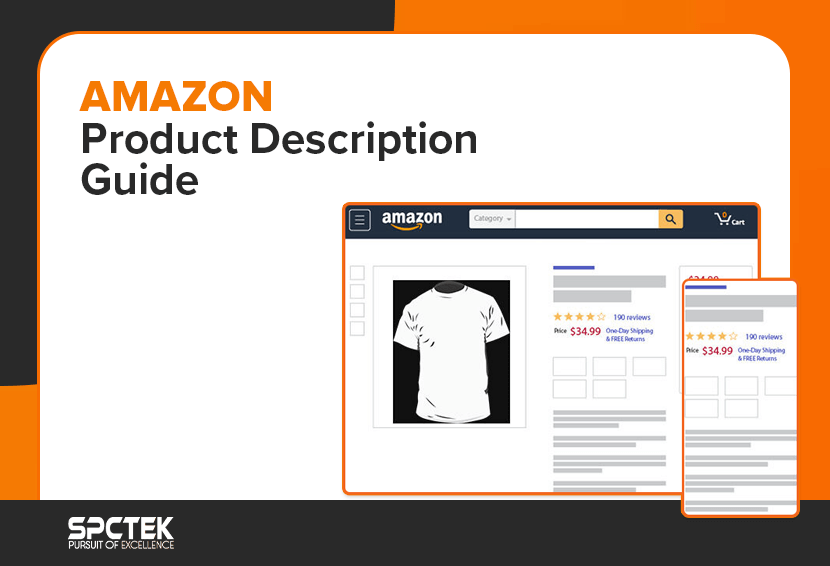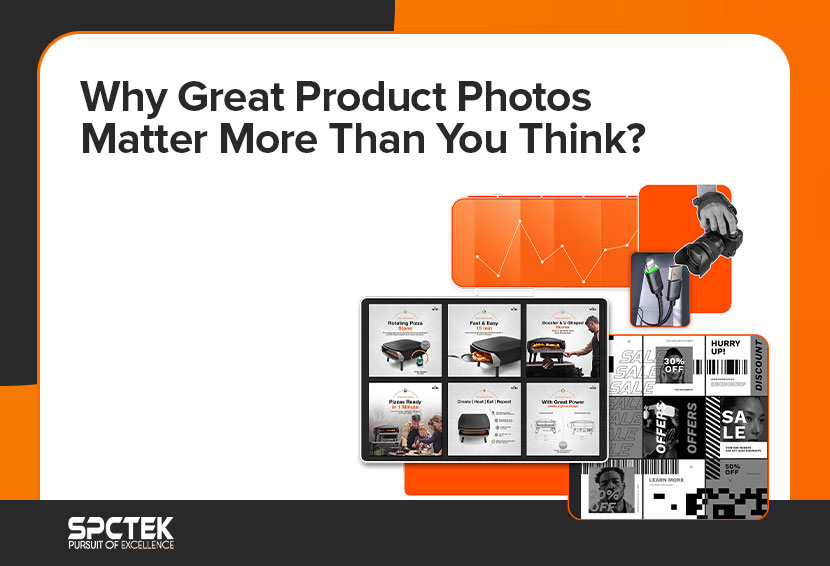In the cutthroat world of Amazon, making your product stand out is not a walk in the park. Every aspect of your product listing has to be on point for your product to thrive on Amazon.
Product description is the cornerstone of an effective product listing. Thus, a well-crafted product description is your gateway to a healthy conversion rate.
This guide provides a complete overview of the dos and don’ts of writing engaging Amazon product descriptions that grab attention and turn visitors into buyers.
We’ll also examine essential best practices and practical tips for optimizing your descriptions for Amazon’s search engine to improve visibility and sales.
What is an Amazon Product Description?
Every item sold on Amazon has a unique product page called an Amazon product listing. This page consists of two basic parts: a product detail page and an offer.
The product detail page showcases your product through description and images, while the offer mentions the price and shipping details. Thus, the product description is a part of the product detail page, and a vital one for that matter.
The structure of an Amazon product description
The product description consists of three sections:
- Product Title: This section has a limit of 200 characters.
- Bullet points section: This section can have 500 characters presented as bullets.
- Main description: The main description section has a maximum of 2000 characters.
We will take a deeper dive into all these sections, so make sure you don’t miss out on important details.
What Amazon consumers look for in product descriptions
Alongside ratings and images, product descriptions and titles are a part of your buyers’ first impression of your products.
A recent survey by PickFu shows that 100% of Amazon customers think that product descriptions are important, while 87% believe that product descriptions are ‘very or extremely’ important.
Here is a summary of the key elements that customers seek in a product description:
- Readability: The description should be easy to read. It should be formatted in bullet points to make it easily scannable. Also, there should be no typos or errors as they reflect poorly on the seller.
- Proper Description of Features and Benefits: The description should mention the key features and their benefits. Note that features are not the same as benefits. Features are the attributes or elements of the product, while the benefits are the advantages that those attributes provide to the buyer.
- Descriptive Title: The title should mention the primary keyword that identifies your product, the product type, brand name, and details like color and size.
10 Essential Best Practices for Optimizing Amazon Product Descriptions

1. Know Your Audience Before Crafting Amazon Product Descriptions
The first step in writing an effective Amazon product description is understanding who you’re writing for.
Consider your target audience and what matters most when shopping for your product. Are the customers looking for durability? Affordability? High-end features?
By aligning your product description with your audience’s needs, you can tailor the messaging to resonate with them.
Your description should address the concerns and preferences of your buyer persona. If you’re selling tech gadgets, emphasize technical specs and convenience. If it’s a fashion product, highlight the materials, style, and comfort.
Tip: Infuse your buyer persona into your description
To gain the trust of potential buyers, your description should reflect the buyer’s persona. Write as though you are speaking directly to the person who would benefit most from your product.
2. Familiarize Yourself With Amazon’s Rules and Guidelines
Before writing your Amazon product description, you must be familiar with Amazon listing best practices.
Amazon has strict guidelines about what you can and can’t include in your product description. Make sure you follow these rules to avoid your listing being flagged or removed.
Tip: Avoid the following things in Amazon product descriptions
Based on Amazon listing best practices, these are the things you should avoid in descriptions:
- Obscene, offensive, or derogatory content.
- Phone numbers, addresses, e-mail addresses, or website URLs.
- Details of availability, price, or condition.
- Use uppercase letters only at the beginning of each word. Do not type in all uppercase letters. This applies to product titles, bullet points, and product descriptions.
- Links to other websites for placing orders or alternative shipping offers, such as free shipping.
- Spoilers on Books, Music, and Video or DVD (BMVD) listings. This includes giving away plot details crucial to a story’s suspense or surprise ending.
- Reviews, quotes, or testimonials.
- Requests for positive customer reviews.
- Adverts, promotional material, or watermarks on images, photos, or videos.
- Time-sensitive information, such as dates of tours, seminars, or lectures.
3. Keep Your Amazon Product Descriptions Simple and Effective
One of the top Amazon product description best practices is to keep your descriptions simple and easy to understand.
Avoid using overly complex language or jargon that might confuse potential customers. Instead, focus on delivering clear and concise information about the product’s features and benefits.
Tip: Use bullet points for key features
Bullet points help break down important details and make your product description easier to scan. Include the most important features in this section, and make sure they highlight the value your product offers.
Tip: Keep your Amazon product description length between 100-300 words
An optimal Amazon product description length ensures your description provides enough detail without overwhelming the reader. Keep the content focused and concise while covering all necessary features and benefits. The maximum length for a description is 2000 characters(including spaces), which includes the HTML code.
4. Avoid Overselling in Your Amazon Product Descriptions
While it’s important to highlight the best features of your product, overselling can backfire.
Making unrealistic claims or exaggerating the benefits of your product can damage your credibility and lead to disappointed customers.
Be honest in your description of Amazon products, emphasizing what makes your item unique while setting realistic expectations. Remember, authenticity fosters trust, which in turn boosts conversions.
5. Optimize Amazon Product Title
Creating a precise product title that complies with Amazon guidelines is essential. Failure to adhere to the requirements can negatively affect your product’s visibility.
Ensure your Amazon product title is effective and provides relevant information because the same title appears in the Google search results and Amazon sponsored ads.
Amazon specifies the following guidelines for the product title:
- Length: The title should not exceed 200 characters.
- No promotional or subjective comments: Promotional offers like ‘free shipping’ and comments like ‘best quality’ are not allowed.
- Product-identifying keyword: The title must have basic identifying words like ‘running shoes’ or ‘digital watch’.
- No ornamental characters: Avoid using decorative characters like ~ ! * ~ { } #.
- No merchant name: Don’t write your merchant name in the title.
Tips for effective Amazon product titles
While complying with the guidelines, you can follow these tips to create effective titles:
- Be concise: Aim between 60-80 characters. For some categories, more characters are acceptable too.
- Do not use ALL CAPS: Only capitalize the first letter of each word, except for prepositions, conjunctions, or articles.
- Use numerals: Use “2” instead of “two”.
- Use necessary punctuation: Such as hyphens (-), forward slashes (/), commas (,), ampersands (&), and periods (.).
- Abbreviate measurements: Use “cm”, “oz”, “in”, and “kg”.
- Mobile view: Maximum 80 characters are displayed in the mobile view
Tip: Difference between parent & child ASINs
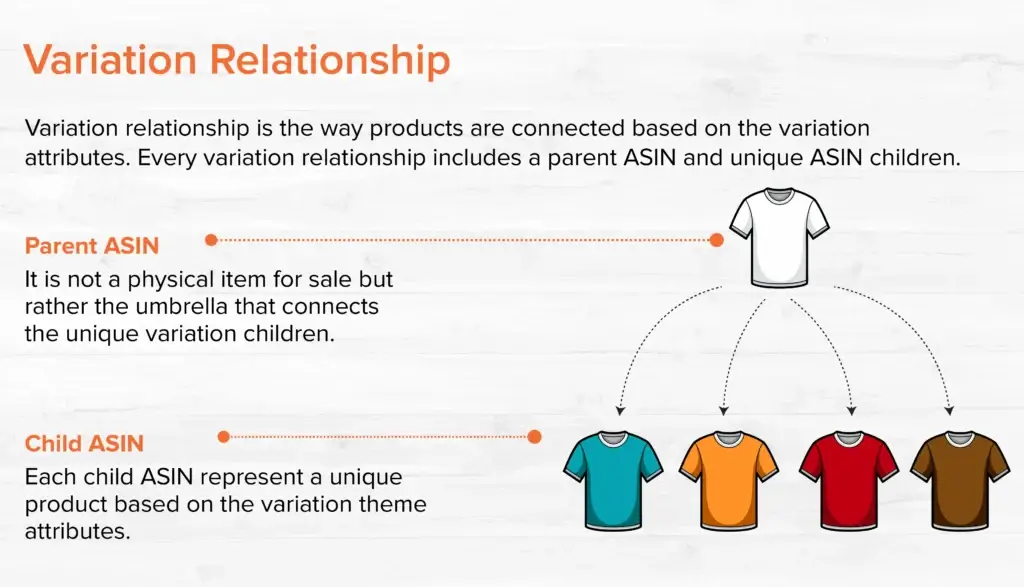
Every product on Amazon is assigned a 10-letter ID number called ASIN (Amazon Standard Identification Number).
A product can come in several different sizes, colors, and other attributes. Each combination of these attributes is called a variation. Each variation of a product is called its child ASIN, and the product in general, without considering the variations, is the parent ASIN.
Only a child ASIN is purchasable; the parent ASIN is a general abstraction of its child ASINs. So, size and color should not be mentioned in the parent product title; they should only be mentioned in the child ASIN. However, this can vary based on the product category.
6. Focus on Key Product Features and Benefits in Your Amazon Descriptions and Bullet Points
The bullet point section provides space to showcase your product’s standout qualities. Ensure that you mention the key features and benefits of the product while using the primary and secondary keywords that best describe your product for your audience.
Following is an Amazon product description sample for a women’s sneaker, highlighting the key features and benefits:
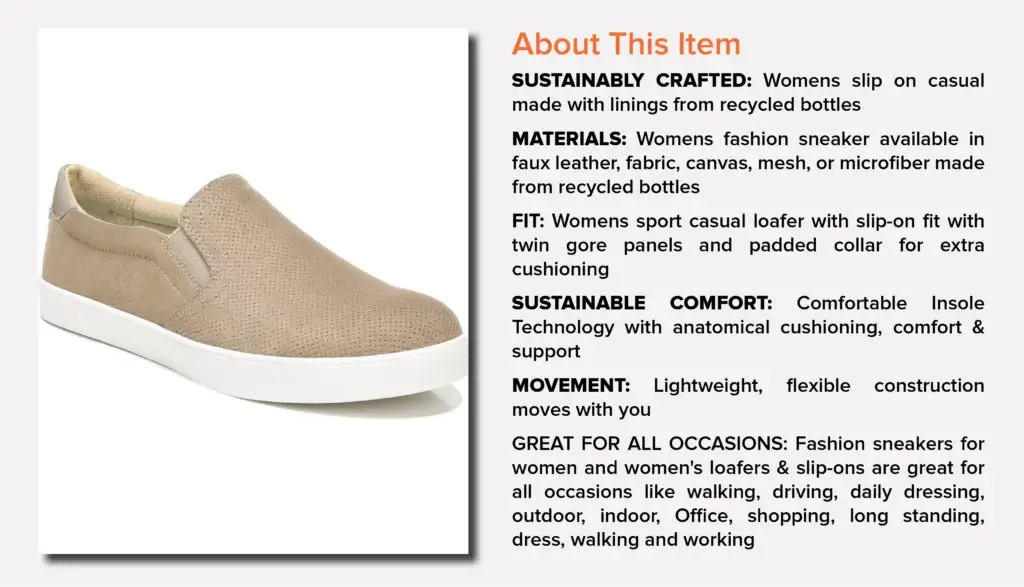
By emphasizing both practical and unique features, you’ll give potential buyers the information they need to make a confident purchasing decision.
7. Increase Conversions with Enhanced Brand Content (EBC) or A+ Content
If you’re a registered brand on Amazon, take advantage of Enhanced Brand Content (EBC) or A+ Content to make your product listings stand out.
These Amazon tools allow you to add premium visuals, custom layouts, and detailed descriptions to your Amazon product detail page, which can help build trust and increase sales.
A+ Content can elevate your product description with more engaging visuals and storytelling, helping customers feel more confident in their purchase decisions.
Also Read: What Is Amazon Enhanced Brand Content & Why You Need It?
8. Optimize Product Descriptions for Amazon’s A9 SEO Algorithm
Keywords are the basic building blocks of any search engine. Relevant keywords help Amazon identify the product based on the product type, features, and benefits.
Like other search algorithms, such as Google’s, Amazon’s A9 algorithm works on the basis of relevance and search intent. However, the key difference is that Amazon only identifies one search intent: transactional.
Tip: Increase Click-Through Rates with Keywords and Backend Search Terms
- Include keywords naturally: Don’t stuff your product description with keywords, but do ensure the essential keywords appear naturally throughout the text.
- Leverage backend search terms: Besides using keywords in your description and bullet points, use backend search terms to boost your listing’s search performance. Backend keywords are not displayed in the description as they are only meant to be read by the Amazon algorithm for product identification.
Tip: Other important ranking factors
Amazon is an online marketplace aiming to sell as many products as possible. So, Amazon A9 naturally favors high-selling items. The two most important ranking factors apart from keywords are:
- Sales volume: Amazon interprets a high sales volume as a mark of relevance for its buyers. So, products with more sales consistently rank higher in Amazon search results.
- Conversion rate: A low conversion rate can result in a drop-off in ranking, even if your product gets impressions and clicks.
Also read: How to Dominate Amazon Keyword Rankings and Crush Competition in 2024?
9. Use the Right Tone of Voice for Your Audience
The tone of voice in your Amazon product description plays a crucial role in engaging your target audience. For example, a playful tone might work well for a children’s toy, but a more professional tone may be necessary for a piece of tech or home appliance.
Ensure that your tone of voice aligns with the product and appeals to your intended audience. The right tone fosters trust, builds connections, and helps potential buyers choose the product.
Tip: Choose your tone according to your potential audience
Use a tone that fits the product category. For example, a sleek and professional voice works well for technology products, while a warm, approachable tone might be more suitable for lifestyle items.
10. Review and Proofread Before Publishing
Before you publish your product description, take the time to carefully review and proofread it. Grammatical errors, typos, or awkward phrasing can make your product listing appear unprofessional, which may deter potential buyers.
Run through your product description to ensure it’s error-free, reads smoothly, and includes all the necessary information. Double-check that your keywords are placed naturally and that your content follows Amazon product description best practices.
Tip: Have a fresh set of eyes review your description
Having someone else review your product description can help identify any issues or improvements you may have missed. Taking this measure will ensure that the content is refined and appealing.
Some Bonus Tips
We have covered the main aspects of Amazon product descriptions in detail. Here are some additional tips that can come in handy.
1. Optimize Your Product Images
When it comes to uploading images, complying with the technical requirements set by Amazon is crucial. If your images fail to meet the requirements or violate Amazon policies, they will not be uploaded.
Every product should have at least one image, but Amazon recommends six images and one video. The recommended image format is JPEG; however, you can use other acceptable formats too.
Here are the key considerations for uploading product images according to Amazon product image requirements:
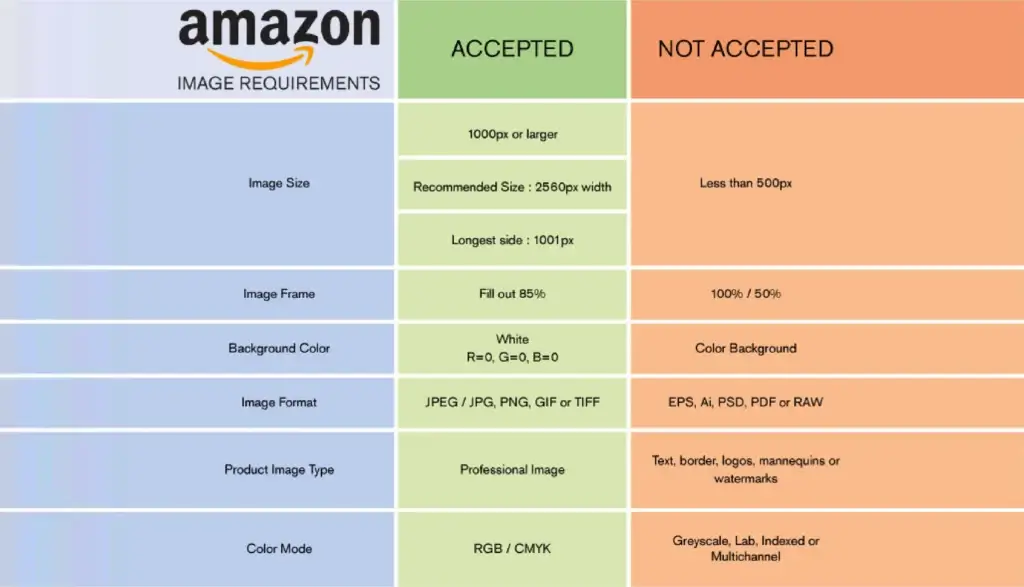
- Images must be at least 1,000 pixels on the longest side and at least 500 pixels on the shortest side to be zoomable.
- Images must not exceed 10,000 pixels on the longest side.
- Images must be provided in JPEG (.jpg or .jpeg), TIFF (.tif), PNG (.png), or non-animated GIF (.gif) file formats.
- Images must be clear, unpixellated, and have no jagged edges.
- Images must be authentic, accurate, and match the product title
- Images must be high-quality and professionally shot.
- Images must show children’s clothing flat with no model.
- Images must have a pure white background
- Images must not have customer reviews, shipping offers, or claims.
- Images must not have any text or pricing details.
- Images must not have Amazon logos or trademarks.
Remember that the first image on the product detail page is the main product image. This image is displayed in the search results. Make sure this image is a high-quality photograph and not a placeholder (illustration, graphic, mock-up, etc).
Moreover, the main image should have a pure white background, with the product occupying 85% of the image.
Image guidelines vary slightly based on the product category. For more specific information, you can visit this page on Amazon Seller Central.
2. HTML Code for Amazon Product Descriptions
Amazon’s rules for the product detail page mention that HTML, JavaScript, or any other type of code should not be used. Thus, HTML code is not allowed for formatting the descriptions in bold or italics, except for the < /BR > tag for breaks.
3. Hire an E-commerce Copywriter
Writing compelling Amazon product descriptions requires skill and experience in e-commerce.
Hiring a professional copywriter who knows the ins and outs of Amazon guidelines and best practices can help you create engaging descriptions.
Professional copywriters can optimize product descriptions by balancing keywords and expressing features and benefits effectively. So, hiring an e-commerce copywriter can prove to be a profitable investment.
4. Amazon’s Generative AI tool for Creating Product Descriptions
You can also use Amazon’s generative AI tool to create high-quality product listings and descriptions.
This tool allows you to generate a complete product description using the brief description and primary keywords provided by the seller.
You can also just upload an image of the product, and Amazon AI will automatically generate the product title, description, and even more product attributes.
Besides Amazon, many other free and paid AI tools are available online for creating product descriptions.
Final Thoughts
Optimizing your Amazon product description is essential for maximizing conversions. By following these recommendations and best practices, you can create engaging and effective product descriptions to enhance product visibility and grow the conversion rate.
Got More Questions?
A compelling Amazon product description is clear and concise and meets Amazon’s criteria. It should appeal to potential customers by clearly highlighting the features and benefits of the product. It should also contain the relevant keywords for product identification.
The key elements of an effective product description are:
- Readability
- Appropriate description of features and benefits
- Authenticity
- Keyword optimization
- Compliance with Amazon guidelines
You should always avoid the following mistakes when writing an Amazon product description:
- False promises or overselling the product
- Typos and language errors
- Unnecessary information and complex language
- Mentioning pricing, shipping offers, and guarantees
- Lack of a proper descriptive title
- Noncompliance with Amazon rules
To increase Click-through Rate (CTR) and sales, your Amazon product description must be optimized for Amazon’s search algorithm to gain visibility. Also, the description should be compelling for potential customers by effectively highlighting the product’s value.
The maximum limit of the Amazon product description is 2000 characters, and that of the product title is 200. So, remember to utilize this space wisely.
Every product should have at least one image, but Amazon recommends six images and one video. The recommended image format is JPEG, but other formats like TIFF (.tif) and PNG (.png) are also acceptable. Images must be at least 1,000 pixels on the longest side and at least 500 pixels on the shortest side to be zoomable. Images must not exceed 10,000 pixels on the longest side.

